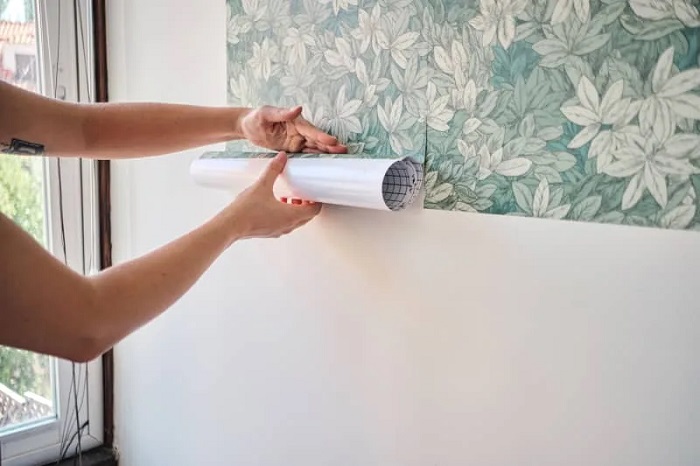
16 Nov Why homeowners regret DIY wallpaper installation
Wallpaper is experiencing a major comeback in home design, offering texture, character, and visual depth that paint alone can’t achieve. But as homeowners become increasingly inspired by online tutorials and budget-friendly DIY videos, many decide to handle wallpaper installation themselves. The reality, however, is that wallpaper installation is one of the home projects most likely to end in frustration, wasted materials, and costly corrections.
Below are the reasons professionals consistently see homeowners regret taking the DIY route.
1. Surface Preparation Is More Complex Than It Looks
The foundation of every successful wallpaper installation is perfectly prepared walls. This means:
- patching micro-imperfections
- sanding uneven surfaces
- repairing previous paint damage
- sealing porous drywall
- correcting texture inconsistencies
- dealing with moisture-exposed areas
Miss even one step, and the wallpaper will bubble, lift, or fail to adhere properly—issues that often don’t appear until days later.
Professional installers spend years learning to evaluate surfaces, select the right primers, and prepare walls based on the wallpaper material. Most DIY attempts skip or underestimate this stage entirely.
2. Pattern Matching Requires Precision and Experience
Matching patterns—especially geometric, floral, metallic, or textured designs—is far more difficult than cutting and aligning panels.
Professionals must consider:
- pattern repeat
- vertical alignment
- horizontal shift
- light reflection
- material stretch or expansion
- batch variations
Homeowners often discover too late that a small misalignment at the ceiling becomes a major visual flaw across an entire wall. Even a 2–3 mm deviation can ruin a premium wallpaper pattern.
3. Cutting and Trimming Mistakes Are Expensive
Wallpaper is one of the few materials where a single bad cut can ruin an entire panel. High-quality materials such as grasscloth, textile, or custom prints cost significantly more per roll than standard paper.
Most DIY projects end with:
- over-trimming around corners
- tearing delicate materials
- mis-measuring complex areas
- cutting panels too short
- wasting an entire roll due to a single mistake
According to professionals in Colorado (https://enjoythewall.com), homeowners regularly underestimate the precision needed when trimming around windows, niches, and ceiling transitions.
4. Material Behavior Is Not What People Expect
Every wallpaper type reacts differently:
- vinyl stretches
- non-woven expands when wet
- grasscloth frays
- textile absorbs moisture
- peel-and-stick is unforgiving to reposition
- murals must align perfectly across large surfaces
Most DIY installers assume all wallpapers behave the same, only to find out mid-project that the material requires completely different tools, adhesives, or techniques.
5. Corners, Ceilings, and Problem Areas Are Extremely Technical
The most challenging areas aren’t the large flat walls—they are:
- inside and outside corners
- ceilings
- wall niches
- around cabinets
- near tile edges
- behind plumbing fixtures
Professionals know how to:
- maintain pattern continuity around corners
- avoid tearing during bending
- taper thick materials
- cut with millimetric precision
- avoid stretching or distortion
These are the areas where DIY projects almost always fail and where the most visible mistakes occur.
6. Adhesive Selection Is Critical
The wrong adhesive can cause:
- staining
- bubbling
- peeling
- shrinking
- seam separation
- mold growth in humid rooms
Manufacturers often list a generic recommended adhesive, but professionals adjust the adhesive type and viscosity based on:
- wall condition
- wallpaper weight
- climate
- humidity
- installation area
- substrate compatibility
This knowledge comes from training and experience—not from online instructions.
7. Removing Failed DIY Wallpaper Is Expensive
When DIY installation goes wrong, the cost of removal and re-installation is often higher than hiring a professional from the start. Improperly installed wallpaper can:
- damage drywall
- tear off paint layers
- leave glue residue
- require full resurfacing
- add hours of labor for correction
In severe cases, entire sections of wall must be repaired before new wallpaper can be installed.
8. The Final Result Rarely Matches the Vision
Even when wallpaper is installed “correctly,” DIY projects often end with:
- visible seams
- crooked lines
- lifted edges
- inconsistent pattern flow
- uneven cuts
- gaps around corners or trim
The difference between a DIY and a professional installation is immediately visible—especially with high-end designer materials.
What Homeowners Should Keep in Mind
DIY wallpaper installation seems appealing at first: it appears simple, inexpensive, and creative. But the technical demands of proper installation, combined with the cost of premium materials, make wallpaper one of the most regret-inducing DIY home projects.
Most homeowners discover that the outcome they wanted—perfect alignment, flawless seams, and professional-grade detail—requires skills that take years to master. That’s why, in the long run, hiring an experienced wallpaper installer is often the most cost-effective and aesthetically satisfying choice.




No Comments